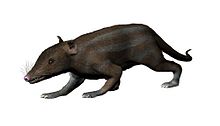Juramaia
| Juramaia | |
|---|---|

| |
| Restoration | |
| Scientific classification | |
| Domain: | Eukaryota |
| Kingdom: | Animalia |
| Phylum: | Chordata |
| Class: | Mammalia |
| Clade: | Eutheria |
| Genus: | †Juramaia Luo et al., 2011 |
| Species | |
Juramaia is an
.Discovery
It was collected in the Daxigou site,
Jianchang, from the Tiaojishan Formation dated at about 160 million years ago.[4] It was first named by Zhe-Xi Luo, Chong-Xi Yuan, Qing-Jin Meng and Qiang Ji in 2011 and the type species is Juramaia sinensis.[5]
Evolution
The discovery of Juramaia provides new insight into the evolution of placental mammals by showing that their lineage diverged from that of the marsupials 35 million years earlier than previously thought.[5] Furthermore, its discovery fills gaps in the fossil record and helps to calibrate modern, DNA-based methods of dating the evolution.[6][7] Based on climbing adaptations found in the forelimb bones, it has been suggested that the basal stock of Eutheria was arboreal,[5] in a manner resembling that of modern rats.[8]
Classification
| ||||||||||||||||||||||||||||||||||
See also
References
- ^ "Juramaia sinensis - 160-Million-Year-Old Fossil Pushes Back Mammal Evolution". Archived from the original on 2012-03-27. Retrieved 2011-09-09.
- LiveScience. Retrieved 5 December 2017.
- ISBN 978-1400834112.
- .
- ^ S2CID 205225806. Archived from the original (PDF) on 10 November 2013. Electronic supplementary material
- ^ "Fossil redefines mammal history" BBC News
- ^ Discovery of a 160-million-year-old fossil represents a new milestone in early mammal evolution
- PMID 26933950.
